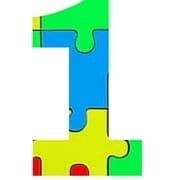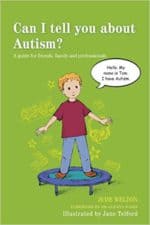Autism Awareness Day Sat April 2nd (or anytime in April is Autism Awareness Month)
Your opportunity to make Big Difference in 2016
Great Books to Read to Children, Students, Family & Community during April
Acceptance is the key to making a difference. When people understand that a child with ASD learns differently and needs different supports I see the BIGGEST difference for the child, family and school.
There are three parts to understanding the ASD diagnosis:
-
When to Tell a Child
-
What to Tell a Child
-
Who and How to Tell (Talking to Class, Peers)
TO DOWNLOAD EASY TO PRINT VERSION OF THIS BLOG
Part 1: When to Tell the Child
Dr Tony Attwood recommends you tell the child around seven years of age or when they start noticing difference.
“Diagnosis for my son opened a whole lot of self-acceptance for him. He realised that although he always felt different, that there was a group of people who are the same as him. We viewed diagnosis as a tool to help us and others best help our son. School has been very supportive, and family have had greater understanding of the ‘weird things’ that my son has done.” Jenny
Part II: What to Tell a Child
Dr Stephen Shore has a wonderful video* you can watch on my website that gives a ‘Four Step Approach’ to telling a child they have ASD. He believes not telling children can have a negative effect on self-esteem as they already notice their differences they just don’t know ‘what it is!’ He answers a range of questions including: When to tell? Will they use as an excuse? How to explain to siblings? I have summarised the video below:
Four Step Approach:
- Talk about strengths and challenges of an ASD diagnosis.
- Lining up strengths and challenges and seeing how strength can accommodate challenge.
- Non-judgmental comparison – looking at other people’s strengths and challenges and how they use their strengths.
- Revealing diagnosis. Explain scientists and doctors have done studies and these characteristics have been given a name called Autism/Asperger’s.
Note: This is actually not telling them something they don’t already know. You are giving a framework of understanding.
Self-knowledge is a process that continues throughout a person’s life. Do not try to explain everything you know about ASD all at once. Continue the discussion as the child matures.
Knowledge is precursors to helping children learn to advocate for themselves. They must understand their strengths and challenges – and what can help. Help them learn when and how to ask for help and who to turn to when they need assistance. Educating key people in their life is also a necessity, so they understand ‘why’ and ‘how’ to help.
Part III: Talking to Class, Peers
As an educator I believe talking to all children about ‘differences’ at the start of the year when setting up the class expectations is vital. Otherwise you will probably get questions and comments from children wanting to know why some accommodations may be made for students with ASD that won’t be available to them. It makes sense that all children have an understanding of ASD. Just like we teach children about food allergies, asthma, cultural difference we need to educate whole communities about ASD.
9 Key Strategies to Promote Understanding in the Classroom
1. You must first have permission from parents to discuss the child’s ASD in the classroom.
- Conduct the ‘My Life in a Box’ activity. This is a fantastic activity for the whole school. ‘My Life in a Box’ is where for News each child brings in a box with objects that tell us about themselves e.g. favourite book, places they have been on holidays, favourite food, favourite colour, sport, pets, etc. If the child has ASD or has a sibling with ASD they can include a book about ASD to read to the class. It is VERY important they talk about all the other interests they have first and then say “I have Autism/Aspergers”, or “My brother, sister, cousin, etc has Autism/Aspergers.” Encourage ALL students to bring in epi-pens, asthma puffers, cultural objects or family traditions so everyone has something ‘different’.
- Explain ASD at the right level for the class. (I highly recommend All Cats Have Aspergers – early years to secondary love this book).
- Give real life explanations about the sensory issues that students experience such as touch, movement, smell, etc. “When Johnny walks out the door at lunchtime he finds it hard when people touch him as he moves. When he is bumped into accidentally he may push you away.”
- Read stories to the class and explain the issues discussed in the book and relate them to what the students see in the student with ASD. (I highly recommend Can I Tell You About…. Aspergers / Autism / ADHD – a great series of books).
- Explain how and why the child may play differently to other children. Give children strategies to encourage someone with ASD to play with them.
- Explain how children with ASD need sensory tools in the classroom.
- Explain how to be a friend to someone with ASD.
“My son (8yrs at the time) wrote a book titled ‘My Asperger’s’. He read it to the class. The school library published it, and it is still on the shelf today. An amazing and supportive school community.” Charmaine
For more information download my free Tip Sheet ‘Promote Understanding in the Classroom’ from my Tip Sheet Page
Help Children Embrace Difference
With better understanding about difference, children learn to Embrace Difference to Make a Difference. Make time to share a book with your class, family, and community about Autism Spectrum Disorder (ASD). Books are a fantastic way to communicate the complex nature of ASD and help EVERYONE understand.
These books provide a valuable resource for:
- Teachers wishing to convey to their students the behavioural characteristics of children with ASD.
- Families to share with child with ASD, siblings, cousins and extended family.
- Preschools and schools wanting to discuss diversity and explain ASD.
- Increasing tolerance and understanding of children who think and behave different to their peers.
- Supporting children with ASD, to understand ASD and that it is okay to be different.
Great Resources for Talking to Children About ASD
——————————————————————————————————————————————-
Gus the Asparagus: By Kaylene Hobson and Ann-Marie Finn
Meet Gus! Gus might be the only asparagus in his family, but he is happy. However, when he goes to school he starts to realise that he doesn’t always ‘fit in’. Gus is here to help kids understand that it’s ok to be different. He will soon become a favourite with anyone who has ever felt a little bit out of place, kids and adults alike.
I am an Aspie Girl: By Danuta Bulhak-Paterson, Foreword by Tony Attwood
Lizzie is an Aspie Girl – she has Asperger Syndrome, which means that her brain works differently to her friends and even to boys with Asperger Syndrome. In this book, Lizzie explains what it is like to be an Aspie Girl, including how she has a special talent for blending in with her friends, how she gets really tired after being at school all day, how she worries about making mistakes, and how she finds it hard to understand how she is feeling.
All Cats Have Asperger Syndrome: By Kathy Hoopmann
This book takes a playful look at Asperger Syndrome (AS), drawing inspiration from the feline world in a way that will strike a chord with all those who are familiar with AS. This engaging book is an ideal, gentle introduction to the world of Asperger Syndrome.
Can I Tell You About Autism: By Jude Welton
Meet Tom – a young boy with autism. Tom invites readers to learn about autism from his perspective, helping them to understand what it is and explaining the challenges he faces with issues such as social communication, sensory overload and changes in his routine. Tom tells readers about all the ways he can be helped and supported by those around him. This beautifully-illustrated book is ideally suited for readers age 7 and upwards, and will be an excellent way to increase understanding about autism, in the classroom or at home. It also includes clear, useful information for parents and professionals.
Kevin Thinks: By Gail Watts
Kevin Thinks is the story of a boy with Aspergers Syndrome who sees the world a little… differently! His quirky observations will strike a chord with all those who are familiar with AS, from his special interest in outer space and his aversion to itchy clothes, to his (mis) understanding of non-literal expressions and his tendency to say exactly what he thinks, regardless of the consequences, whilst the accompanying illustrations reveal what is really happening from a neurotypical point of view, to often hilarious effect.





 Sorry we no longer ship items outside Australia. Please consider the digital versions of Sue’s Books –
Sorry we no longer ship items outside Australia. Please consider the digital versions of Sue’s Books – 